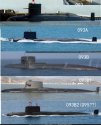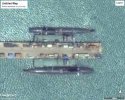Agree with the rest but need to remind that 09III is double hull construction? So although its exterior is bigger, its pressure hull maybe smaller, therefor require a hump on the exterior for the protruding.
The use of the term single and double hull is misleading, when designs are tend to be hybrids, and the ballast tank arrangement differs by section.
The front of the sub would be double hulled, as well as the taper on the rear. Meaning the ballast tanks are all around an inner cylinder, or ballast tanks wrapping around an inner hull.
In between a sub can have sections that are monohulled, with no ballast tanks; or sections that have shoulder ballast tanks, where in the ballast tanks are on top. Some people also call this single hulled. Sections that have ballast tanks on the side are somehow called double hulled. European SSKs like the Gotland, Type 212 and 214 designs are all shoulder mounted ballast tanks all along its length. The Russian Amur/Lada class is also shoulder mounted. The Kilo class, Song and Yuan class have ballast tanks along the side, with the front and rear sections being wrapped around. The Japanese Soryu class is a hybrid, the front and rear sections are double hulled, or ballast tanks around an inner hull, but the middle doesn't have ballast tanks, and is single hulled.

I suspect that on the Type 094, the front section is wrapped around ballast tanks. The next section with the sail has the ballast tanks to to the side until you reach the section with the hump and ballistic missiles are. On this hump, and its quite visible, the ballast tanks are on the top where the hump is, and this section does not have side mounted tanks, making it single hulled and allow for more room within. Once you are past this section, you have side mounted ballast tanks, and then the taper to the rear propeller would have wrapped around tanks.
I suspect that on the Type 093 (small hump), the entire hump section is a shoulder mounted ballast tank which extends to the aft and forward ballast tanks that wrap around the sub. The sink hole, which is the term for the lines of holes where the air comes out of the ballast tanks, extends as a single line from the aft tank, to the middle shoulder tanks, and to the forward tanks. This would be consistent to the structure of the Type 094 I described above where the two subs are basically same sub with this middle section changed, and share common sections.
If you move the ballast tanks from the side to the shoulder, this frees more room on this entire section, and that can be used to house a larger reactor. The hump itself is there to create additional ballast tank volume.







